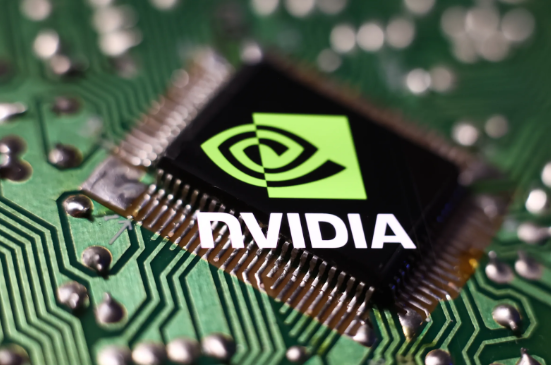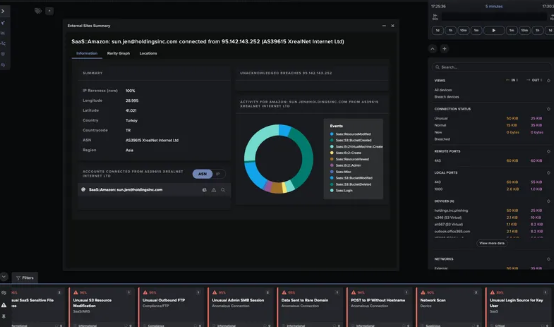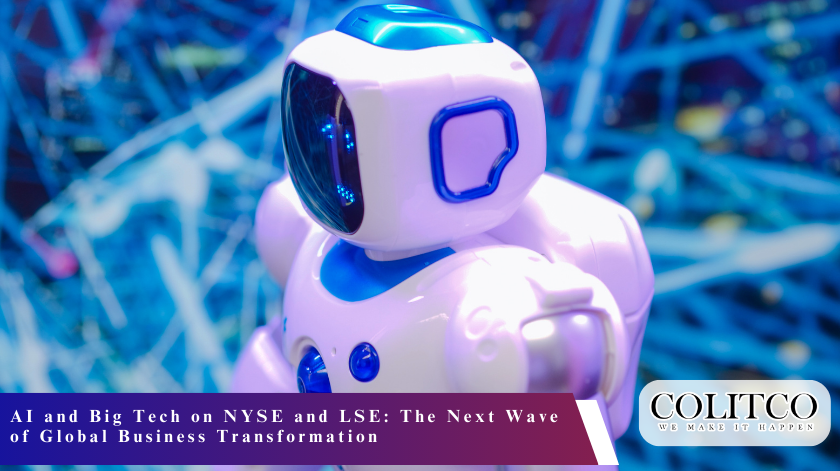AI and Big Tech stocks in 2025 are revolutionizing the financial markets in both the New York Stock Exchange (NYSE) and the London Stock Exchange (LSE). The world’s investors are keeping close tabs on the performance of major corporations as artificial intelligence continues to drive growth, determine global competitiveness, and challenge traditional valuation models. With AI integration becoming an indispensable element of company strategy, the financial landscape for both the U.S. and European markets is headed into a revolutionary period.
Nvidia Market Domination

Nvidia’s AI chips continue to anchor global data center expansion and drive NYSE tech valuations.
Nvidia has an uncontested position as the leader in AI hardware. The company has just become the first company in history to surpass a $4 trillion market cap. Its chips have a commanding presence in the majority of the world’s AI data centers, and its quarterly reports are now the benchmark for the industry’s momentum.
The company has added an astonishing $500 billion in shareholders’ value within weeks of its latest quarterly report. Analysts are forecasting Nvidia to report $46 billion in quarterly revenues, a 53% increase from last year. Earnings per share are forecast to rise 49% to $1.01. While the numbers are healthy, the rate of growth has slowed from the triple-digit gains of last year, suggesting that AI deployment may be entering a more consistent but still good growth phase.
Nvidia’s H100 and future B200 series GPUs continue to lead the training and inference market for large language models (LLMs). The company has also diversified into software via its CUDA platform to secure a full ecosystem advantage that is hard for others to copy.
Microsoft and the $4 Trillion Club
Microsoft, with a market capitalization of $3.76 trillion, is just shy of entering the $4 trillion club alongside Nvidia. Its massive investments in OpenAI and the integration of AI into its products, including Microsoft Copilot and Office 365, have even further entrenched its competitive moat. Azure, Microsoft’s cloud platform, is at the forefront of its AI game plan, with hyperscalers projected to invest over $325 billion in capital expenditure for 2025.
Despite this, Microsoft’s stock has fallen around 5% thus far in 2025. This decline reflects investor caution on AI adoption rates and mixedness on monetization horizons. Still, experts are bullish, using Microsoft’s dual role as an enabler of AI infrastructure and a software applications titan. The company remains to lead corporate adoption of AI, from office productivity to developer tools.
Growing Role of AMD
Advanced Micro Devices (AMD) is assuming the position of Nvidia’s strongest competitor. Through its acquisition of Xilinx, AMD enhanced its FPGA power, which gives it a definitive lead in AI workloads with customization. Truist Securities just upgraded AMD to “buy” based on new hyperscaler and cloud provider traction.
Analysts raised AMD’s price target to $213 from $173. The announcement caused a 2% rise in the company’s stock price. While AMD’s market share in AI remains considerably smaller than that of Nvidia, its low-cost solutions and growing product line suggest that it could take meaningful market share away from data centers.
AI Mega-Cap Stock Leaders

The top AI mega-cap stocks as of August 2025 are:
- Nvidia (NVDA): $4.27 trillion
- Microsoft (MSFT): $3.76 trillion
- Apple (AAPL): $3.35 trillion
- Alphabet (GOOGL): $2.41 trillion
- Amazon (AMZN): $2.39 trillion
- Meta (META): $1.88 trillion
- Broadcom (AVGO): $1.37 trillion
- Tesla (TSLA): $1.04 trillion
- Oracle (ORCL): $660 billion
- Palantir (PLTR): $370 billion
These companies operate in the AI and tech world. Unlike pure-play small AI companies, mega-caps possess vast resources, talent pools, and gargantuan data sets and can experiment at scale and monetize quickly. Their supremacy shows how AI transitioned from a niche experimentation space to a mass phenomenon, driving corporate profitability.
Broadcom’s Semiconductor Growth
Broadcom is riding the growing demand in AI and wireless markets. Citi estimates AI-related sales to increase 60% in fiscal year 2025 and 37% in 2026. Its diversification strategy between enterprise software and semiconductors underpins it as a vital facilitator of AI adoption.
Broadcom’s strength is also enhanced by its infrastructure-level contributions. While Nvidia is the GPU market leader, Broadcom is the networking and specialized chip leader that makes data transmission smooth in AI systems. Its ASIC leadership provides a competitive shield against the cycle variations of consumer hardware markets.
Palantir’s Software Expansion
Palantir Technologies has grown from a niche data analytics business to one of the most critical AI software companies in the world. Palantir’s market capitalization is $370 billion, and it is applying AI to make more informed decisions in government and private industries. Its products, like Foundry and Gotham, have become solid and highly versatile.
Earlier 2025 this year, Palantir’s shares rose more than 150% before backing off as investors reassessed prospects for growth. However, its steady growth in AI-based healthcare, finance, and logistics keeps it attractive to long-term players. The company is a good example of the way in which AI software, as opposed to hardware, is attracting investor attention.
UK AI on LSE: Ocado and Darktrace

LSE-listed firms like Darktrace showcase Europe’s growing role in AI innovation and cybersecurity
The LSE also has its own batch of AI-driven companies offering UK and European continent investors with UK and European continent exposure that goes beyond U.S. mega-caps.
- Ocado Group (OCDO): Has AI-driven logistics for grocery delivery. Its Ocado Smart Platform utilizes robots and algorithmic forecasts to optimize supply chains, though profitability is a concern with margin pressures on retail.
- Darktrace (DARK): With emphasis on AI-driven cybersecurity, Darktrace created solutions that are capable of adaptive threat detection and automated incident response. Aside from stock volatility, its AI-first strategy differentiates it in the cybersecurity market.
They both represent the UK’s rising but lower-scale contribution to the AI revolution.
European AI Adopters

AI capital flows between the US and UK highlight both growth opportunities and systemic risks
Outside the UK, several European software firms like SAP, Dassault Systèmes, Sage, Capgemini, and the London Stock Exchange Group (LSEG) have all adopted AI into their portfolios. Investor sentiment, however, has responded recently with caution. After OpenAI released its GPT-5 and Anthropic released its Claude for Financial Services, the stocks of the companies fell by between 10% and 15% since July 2025.
This sell-off is an expression of investor skepticism about whether established software firms can successfully repel their business models against rapid AI disruption. U.S. companies have thus far had AI tailwinds, but European companies more and more are not so lucky.
Stealth AI Plays: Willdan and CBRE
Some less visible companies are thriving during the AI bubble by serving critical infrastructure:
- Willdan Group (WLDN): An engineering firm providing energy and grid solutions for data centers. In Q2, revenues grew 172% year over year, while stocks went up 218% in 2025.
- CBRE Group (CBRE): The world’s largest real estate services firm, CBRE helps drive data center development globally. Operating in 700–800 data centers, the company expects earnings per share growth of 130% by 2029.
These stealth AI plays illustrate how far-reaching the impact of the AI revolution is on the broader ecosystem, ranging from real estate to utilities.
Market Bubble Fears
Putting optimism aside, however, experts warn that valuations of AI can behave like a bubble. In a report by MIT, it says 95% of AI pilots fail to scale, and Gartner predicts that 30% of generative AI projects will be discontinued by 2025. These statistics raise eyebrows about sustainability.
Nvidia’s valuation at 40 times forward earnings has drawn comparisons to the dot-com bubble. Prominent figures, including OpenAI’s Sam Altman, have warned investors about speculative excesses. The parallels suggest that while AI is undoubtedly transformative, the pace of growth may not justify current valuations.
Investor Rotation and New Strategies
Goldman Sachs has hypothesized a rotation potential for investors from infrastructure leaders such as Nvidia to software stocks that can generate recurring revenue driven by AI. Potential winners for this new world are said to be Palantir, Cloudflare, and SentinelOne.
The logic is simple: when AI infrastructure investment reaches maturity, real long-term returns will be in monetization. This means enterprise SaaS applications, cybersecurity software, and vertical industry applications where AI improves productivity and efficiency in a linear way.
Market Outlook
- NYSE: U.S. mega-caps remain dominant in AI expenditure. Nvidia, Microsoft, and Broadcom remain dominant, with AMD gaining momentum as a challenger.
- LSE: Specialist AI exposure from British firms such as Ocado and Darktrace is available, though at the cost of profitability pressures.
- Europe: European incumbents have significant issues, with market uncertainty regarding whether they can effectively challenge U.S. and Chinese technology behemoths.
Also Read: https://colitco.com/us-ai-regulation-in-2025-what-it-means-for-global/
Final Thoughts
AI and NYSE and LSE-listed Big Tech stocks in NYSE in 2025 still present both dramatic growth opportunities and enormous risks. All-time high valuations testify to investor enthusiasm but also indicate the weakness of assumptions. For NYSE-listed mega-caps, earnings delivery and infrastructure dominance remain essential. For LSE and European-listed enterprises, operating success and reactivity will determine whether and how they will derive significant value from AI.
The second wave of world business transformation is already underway. Those companies that can balance innovation, scalability, and profitability will define the future of AI, deciding not only financial markets but also the general direction of technological advancement worldwide.
FAQS
- Will Nvidia earnings end speculation regarding whether the AI boom is a bubble or a fact?
Nvidia’s earnings offer a fairly accurate indication of the underlying demand for AI infrastructure.
A beat would signal ongoing AI-led growth, while a miss would increase concerns about the bubble.
- What are they expecting from Nvidia’s next quarter’s results?
Analysts are expecting revenue of around $46 billion and adjusted earnings per share of around $1.01.
Those figures bode well for ongoing strong growth, but at a more modest pace than last year’s rate.
- How will trade tensions with China impact Nvidia’s bottom line?
China’s trade restrictions have already reduced Nvidia’s sales by billions.
Any new tariffs or limits would still take substantial revenue away.
- How does Nvidia’s $4 trillion market cap affect world markets?
Nvidia’s size contributes to its market dominance, impacting indices and sentiment.
Its moves can move sector rotations and total equity volatility.
- Why is Nvidia being traded at such high price-to-earnings multiples?
Investors are accounting for expected long-term dominance in AI hardware and software ecosystems.
High multiples reflect growth expectations and perceived scarcity of comparable assets.
- Why are AI spending trends by hyperscalers like Microsoft, Amazon, Alphabet, and Meta significant?
Hyperscalers are spending hundreds of billions of dollars on AI infrastructure and services.
Their capex translates directly into chip demand, cloud services, and data-center gear.
- Are most AI pilot projects successful or failing to generate quantifiable returns?
Noted research suggests that a large percentage of pilots do not scale into production.
Common barriers include organizational readiness, data issues, and poor use-case selection.
- What did the MIT report reveal about enterprise AI deployment failure rates?
The MIT analysis found that a high percentage of pilots did not reach scalable deployment.
The report emphasized operational and organizational obstacles rather than model quality alone.
- Why does OpenAI’s CEO say the AI market may be in a bubble?
Public comments reflect caution about hype outpacing practical, monetizable outcomes.
Leaders worry that lofty expectations will unleash shock re-pricing.
- How are Nvidia’s profits impacting broader stock market activity?
Nvidia’s results provide a gauge for demand in most segments of AI.
Lower or higher figures can impact investor risk tolerance and sector positioning.
- Is Nvidia the most influential stock on the overall market mood today?
With its market capitalization and focus within its industry, Nvidia is definitely so.
Its implementation significantly impacts technology indices and market narratives in the future of tech.
- Can AMD and others realistically challenge Nvidia for AI data center dominance?
AMD shows real momentum through product innovation and hyperscaler adoption.
Nvidia remains the monarch, but AMD can grab niches and grow within-market share.
- What is the long-term investing implication of AI mega-cap stocks rising?
Mega-caps offer scale, cash, and data advantages that support continued R&D.
Investors view them as less risky routes to AI exposure compared to pure plays.
- What other sectors benefit from AI besides chipmakers—e.g., infrastructure, real estate?
Data-center property, power utilities, construction, and software services gain from AI demand.
Land-development, power, and cooling providers are among the best beneficiaries.
- How speculative is the AI stock run-up now compared to the dot-com bubble?
Closely analogous are brisk valuations premised on future promise rather than current profits.
Differences are greater incumbent margins and more certain near-term revenue streams for most companies.
- Which UK or European stocks are associated with the AI trend: e.g., Ocado, Darktrace?
Ocado connects AI to logistics and automated fulfillment operations.
Darktrace uses AI in cybersecurity and adaptive threat detection.
- Are there indications of rotation from AI infrastructure towards software plays such as Palantir or Cloudflare?
Analysts point to increased investor demand for AI-powered software and app revenue streams.
Rotation is likely if infrastructure capex normalizes and monetization accelerates.
- How might regulators and valuations pressure AI mega-caps in the near term?
Regulation could restrict cross-border sales, data usage, or model deployment habits.
High valuations heighten exposure to earnings misses or regulatory blunders.
- What are the main risks to AI stock valuations and long-term growth?
Main risks are valuation overextension, sluggishness in monetization, and geopolitical restrictions.
Operational failures in ramping pilots and competitive disruption risks as well.
- What are some investor strategies to lower the risk of AI bubbles?
Diversify across infrastructure, software, and supporting industries to spread the exposure.
Like companies with proven revenue models, good cash flows, and a clear path to monetization.












